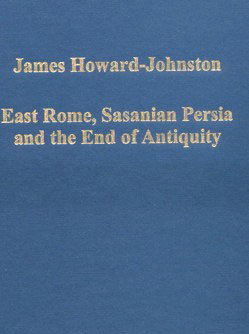
James Howard-Johnson
East Rome, Sasanian Persia and the End of Antiquity
Variorum Collected Series CS848. Aldershot: Ashgate, 2006. £70.00/$140.00 ISBN 978-0860789925.
James Howard-Johnson is the world’s foremost authority on the wars between the East Roman Empire and Sasanian Persia that consumed both powers in the first third of the seventh century, and that laid the groundwork for the unexpected and explosive rise of Islam just after the end of those wars—an event that the author, among others, takes as the real end of the antique world. This extremely useful volume in Ashgate’s Variorum series on Historiographical and Historical Studies collects eight of Howard-Johnson’s specialist articles on aspects of this epic struggle plus one previously unpublished study. Since a number of the articles were first published in obscure journals or as chapters in limited-run archaeological publications, their collection is a real service to the scholarly community. While undergraduate students will find much of the material opaque, the collection is highly recommended for scholars working in the field.
The articles range from 1983 to the present (that is, in the newly-published study noted above), but are arranged according to the chronology of their subject matter, not their publication date. Thus, the collection gains coherence as a sort of composite picture of the era. An initial chapter on “The two great powers in Late Antiquity: a comparison” leads to a final two studies of “Heraclius’ Persian campaigns and the revival of the Eastern Roman Empire, 622-630” and “Pride and fall: Khusro II and his regime, 626-628.” The latter two also illustrate that Howard-Johnson’s perspective on the great conflict encompasses both Roman and Persian perspectives, as well as views from the Armenian middle ground between the great powers.
The studies fall into two types. First, including the three aforementioned articles, are straightforwardly historical: close studies of particular aspects of the extended war. In these, Howard-Johnson’s judgments are always cautious and well-grounded, but have the sure touch that makes them convincing and, in aggregate, add up to an authoritative picture of the Roman-Sasanian conflict. Articles IV, V and VI are the second type: extended critiques of key sources from the period. Here too, Howard-Johnson’s breadth of perspective and linguistic expertise shows. The official history of Heraclius’ Persian campaigns (discovered and extracted from unnoticed citations in later historians), two Armenian historians (Sebeos and Movses Dashkurantsi), and Al-Tabari all come in for careful analysis that in the end reveals that we have more, and more reliable, evidence for early seventh century history than is commonly assumed. It is in these historiographical studies that, with the benefit of hindsight, we can see Howard-Johnson working towards his monumental and essential Witnesses to a World Crisis. Historians and Histories of the Middle East in the Seventh Century (Oxford University Press, 2010), which convincingly rehabilitates almost all the main Arab historians and historical traditions concerning the rise of Islam through careful comparison of them with all the known non-Islamic sources of the period, whose reliability is much easier to establish independently.
Thus, between this collection of studies and the later book for which this collection is both frame and preview, Howard-Johnson has, in effect, written a history of the Middle East in the seventh century that any future studies of the time and region will have to take account of.
